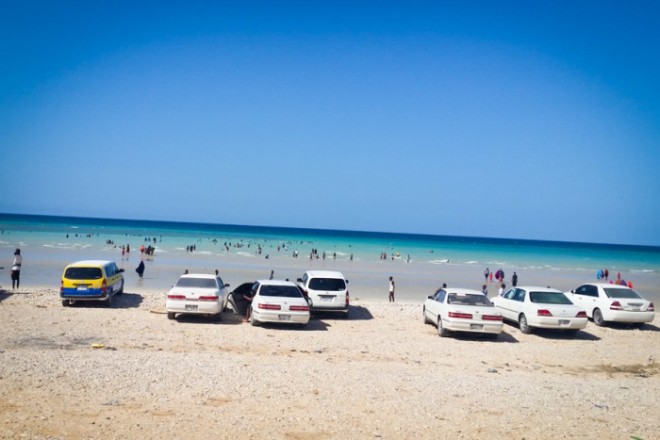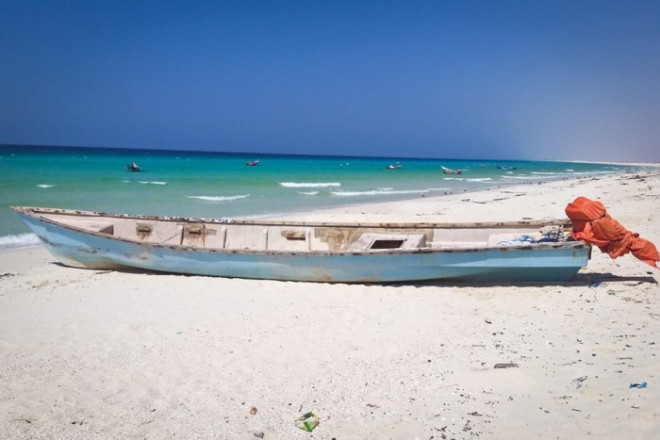
Thursday February 4, 2016
At Jazeera Beach, Mogadishu. It was my first time seeing the ocean in Somalia — a lifelong dream of mine — a full two years after I returned. (Courtesy photo)
The moment my flight lifted off from SeaTac International Airport en route to Somalia was probably the most emotionally conflicted point in my entire life.
I was elated to be returning to my country of birth for the first time since fleeing with my family as a young boy in 1991.
On the other hand, I was extremely uncertain as to what awaited me back home.
Were all the rumors and myths I’d heard about Somalia true? Would my poor command of the Somali language be a hindrance to my repatriation? Would my people back home accept me with open arms? Or would they treat me as an outsider who was only there for a vacation — but would ultimately return back to the creature comforts of a first world life?
All these questions wrestled in my brain along with my debilitating fear of flying.
Looking back on that moment some two years later, I can’t help but laugh at my unfounded trepidations.
My choice to leave Seattle was one of the best decisions of my life.
Initially, being with my family again was the main motivating factor that led to my decision to return.
But I was also getting away from a mostly stagnant and unfulfilling life in Seattle — White Center to be specific.
I was tired of working dead end jobs just to pay the bills. I felt trapped in a vicious cycle, where I always ended up at the same starting point, with no end in sight. I felt as if I was living a real life version of the movie Groundhog Day.
“I’ve seen people come here with a modest amount of savings and leverage it into entire hotel chains.”
After years of feeling out of place in Western culture, while not fully understanding my own cultural heritage, I felt the time was right to take a leap of faith and explore my roots. I wanted to see where I came from. I wanted to learn the foundations of Somali culture straight from the source.
I also hoped to understand the challenges that Somali people were facing on a daily basis.
How could I help my country reemerge from decades of conflict? I needed firsthand knowledge of the ongoing humanitarian climate back home if I was really going to help. This same firsthand knowledge would be invaluable in helping me understand what it meant to be Somali, and conversely, Somali-American.
Culture shock
I was greeted at the “airport” by my mother and three younger sisters. The landing strip was an unpaved dirt and gravel roadway that I’d be happy never to see again. The airport itself was little more than a square, flat-roofed building made of cinder blocks instead of wood and steel — like the typical home in Somalia.
I hadn’t seen my family in a year and a half. They had returned because they were fed up with the culture and way of life in Seattle too. My little sisters needed to learn some valuable lessons that only Somalia could provide — before they began to take all the opportunities and privileges they were blessed with in the States for granted.
My mother needed to return to the clean air, even cleaner food and warm weather of Somalia for health reasons. Living in Seattle for so many years had taken its toll on her physically, and going back home was a surefire way to alleviate what pained her.

Homes in the Bari Region, in Northeastern Somalia. (Photo by Said Maxad)
To say that I experienced culture shock from the moment I stepped off my last flight to the Central Somalia city of Galka’ayo would be the understatement of the century.
It was so oppressively hot that I had to take a few deep breaths just to gather myself before going through baggage claim.
On the twenty minute drive to our house, I was struck by how red the sand was, how bright the sun was, and the multicolored plastic bags that hung haphazardly in trees for as far as the eye could see.
I asked how they got there and was informed that there isn’t really any proper waste disposal in Somalia, so people just litter whenever they need to, or burn big piles of refuse like bonfires. The wind carries the discarded plastic bags through the air until they ultimately get stuck to tree branches.
A few things I learned from my first few days in Somalia were hard to come to terms with it.
For starters, drinkable tap water was a thing of the past for me. In Galka’ayo, the ground water that is pumped into houses is unfit for human consumption due to a high mineral content. It isn’t uncommon to have to pay for multiple types of treated water for different purposes.
The highest grade is intended for drinking and the lowest grade is intended for washing your clothes by hand. That one took me a while to get the hang of, but ultimately, it’s infinitely more rewarding than just tossing them into a washing machine and pressing the start button.
The main form of transportation in Galka’ayo is a big economy van that’s used as a public bus. You pay about 25 cents one way and squeeze into a seat intended for three with four other passengers. It should come as no shock that the windows are usually closed and the AC doesn’t work.
Trial by fire
My immersion into Somali cultural norms and linguistic idiosyncrasies was nothing short of trial by fire. I made more than my share of faux pas in the first few months.

No shortage of parking at the beach. (Photo by Said Maxad)
One day I decided to venture out to the city in shorts and a tank top. I was warned by every single one of my family members to change before I left — that modesty norms in Somalia were not the same as in the States. Typical hard-headed Somali that I was, I decided to go against the advice of my more experienced family and struck out on my journey.
I got more than a few unfriendly stares and disapproving shakes of the head, culminating with two young boys stopping to stare, point and laugh at me for a good five minutes.
I was with my younger brother’s friends, who were all from abroad like myself and had been there long enough to know better. They’d been through some of the same touch adjustments themselves, and told me to just stick to pants and a button up shirt when in public. No need to give people a chance to ostracize you for having Western tendencies.
Back to Somalia: A growing trend
It might seem hard to believe, since you only hear about bombings and violence from mainstream media outlets, but there’s actually an influx of Somali diaspora returning back home, following many continuous years of improved safety and infrastructure development.
Most of the country north of Mogadishu is relatively peaceful, with the self-declared state of Somaliland in the north having no crime to speak of. Terrorism is really only a problem in certain southern Somali cities nowadays, and even that is sporadic at best. You just have to know what areas to avoid.
More and more people are choosing to take their savings and invest in startup businesses and NGOs in Somalia to help rebuild the nation on a grassroots level. East Africa is a booming hub of economic development, and Somalia is poised to become a regional powerhouse as the security situation further improves.
Opportunities for wealth creation exist most prominently in the import/export, hospitality, agricultural, fine dining and manufacturing sectors.
Returning diaspora members are positioning themselves for success beyond their wildest imaginations — especially compared to their prospects in the States. I’ve seen people come here with a modest amount of savings and leverage it into entire hotel chains and various other lucrative entrepreneurial enterprises. Many go on to reinvest a sizeable portion of their earnings into building infrastructure, doing charity work and other ways of directly addressing issues that face marginalized communities throughout Somalia.

Thanks in part to an infusion of investment from the Somali diaspora, the economy is expanding from agriculture and fishing to more industry and services. (Photo by Said Maxad)
True, progress is slow, thanks in large part to common misconceptions about the current security situation and living conditions in Somalia.
But there are so many things to love about living here. We have access to fresher fruits, vegetables and meat than you could ever get in the States. All natural ingredients make the food spectacular, with no added chemicals, pesticides or hormones. The air is unpolluted and fresh, the weather is nothing short of perfect, and the people are easy going.
The pros far outweigh the cons when it comes to living in Somalia.
My hope is that with further exposure to the realities of living In Somalia today, more of the Somali diaspora will invest their time, skills and savings into helping reestablish our country as a model of African excellence.
For me, moving back home has been a life-altering change, but there is nowhere else I’d rather be in the world.
Come through, fam.
Source Seattle Globalist